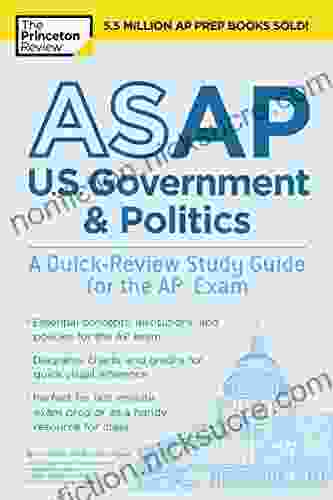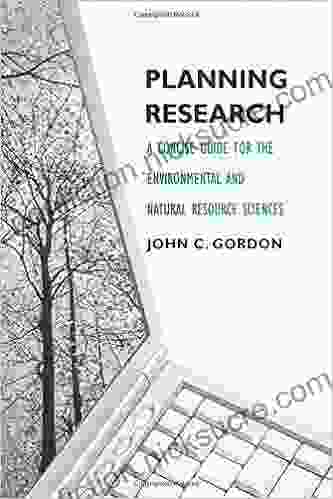A Comprehensive Guide to Environmental and Natural Resource Sciences

Environmental science and natural resource science are two closely related fields that study the environment and the natural resources that we depend on. Environmental science focuses on the physical, chemical, and biological processes that occur in the environment, while natural resource science focuses on the management and conservation of natural resources, such as water, forests, and minerals.
4.6 out of 5
| Language | : | English |
| File size | : | 821 KB |
| Text-to-Speech | : | Enabled |
| Word Wise | : | Enabled |
| Screen Reader | : | Supported |
| Print length | : | 110 pages |
History of Environmental and Natural Resource Sciences
The history of environmental and natural resource sciences can be traced back to the early days of human civilization. People have always been interested in understanding and managing the environment, and this has led to the development of a wide range of scientific disciplines, including ecology, hydrology, geology, and forestry.
In the 19th century, the Industrial Revolution led to a rapid increase in environmental pollution and the depletion of natural resources. This led to a growing public awareness of the importance of environmental protection, and in the early 20th century, the field of environmental science began to emerge as a distinct discipline.
Today, environmental and natural resource sciences are essential for addressing the challenges facing our planet, such as climate change, water scarcity, and pollution. These fields provide the scientific knowledge and tools that we need to make informed decisions about how to protect the environment and ensure the sustainable use of natural resources.
Scope of Environmental and Natural Resource Sciences
Environmental and natural resource sciences encompass a wide range of disciplines, including:
- Ecology: The study of the interactions between organisms and their environment.
- Hydrology: The study of water, including its distribution, movement, and quality.
- Geology: The study of the Earth's physical structure and history.
- Forestry: The study of forests, including their management and conservation.
- Conservation biology: The study of the conservation of biodiversity.
- Environmental chemistry: The study of the chemical processes that occur in the environment.
- Environmental toxicology: The study of the effects of toxic substances on the environment.
- Environmental economics: The study of the economic aspects of environmental issues.
These disciplines are all interconnected, and they work together to provide a comprehensive understanding of the environment and the natural resources that we depend on.
Major Disciplines Involved in Environmental and Natural Resource Sciences
The major disciplines involved in environmental and natural resource sciences include:
- Ecology: Ecologists study the interactions between organisms and their environment. They investigate how organisms adapt to their environment, how populations and communities of organisms change over time, and how ecosystems function.
- Hydrology: Hydrologists study water, including its distribution, movement, and quality. They investigate how water flows through the environment, how it is stored in aquifers and lakes, and how it is affected by human activities.
- Geology: Geologists study the Earth's physical structure and history. They investigate the composition of the Earth's crust, the processes that shape the Earth's surface, and the history of the Earth's climate.
- Forestry: Foresters study forests, including their management and conservation. They investigate how forests grow and change over time, how they are affected by human activities, and how they can be managed to provide a variety of benefits.
- Conservation biology: Conservation biologists study the conservation of biodiversity. They investigate the threats to biodiversity, develop strategies to protect endangered species, and manage ecosystems to maintain their biodiversity.
- Environmental chemistry: Environmental chemists study the chemical processes that occur in the environment. They investigate the sources, fate, and effects of pollutants, and develop technologies to clean up contaminated environments.
- Environmental toxicology: Environmental toxicologists study the effects of toxic substances on the environment. They investigate the toxicity of pollutants, develop risk assessment methods, and identify ways to reduce the exposure of humans and wildlife to toxic substances.
- Environmental economics: Environmental economists study the economic aspects of environmental issues. They investigate the costs and benefits of environmental regulations, develop policies to promote sustainable development, and value the benefits of environmental goods and services.
These disciplines are all essential for understanding and managing the environment and the natural resources that we depend on.
Environmental and natural resource sciences are essential for addressing the challenges facing our planet. These fields provide the scientific knowledge and tools that we need to make informed decisions about how to protect the environment and ensure the sustainable use of natural resources.
If you are interested in learning more about environmental and natural resource sciences, there are many resources available online and at your local library. You can also find information about environmental and natural resource science programs at colleges and universities.
4.6 out of 5
| Language | : | English |
| File size | : | 821 KB |
| Text-to-Speech | : | Enabled |
| Word Wise | : | Enabled |
| Screen Reader | : | Supported |
| Print length | : | 110 pages |
Do you want to contribute by writing guest posts on this blog?
Please contact us and send us a resume of previous articles that you have written.
 Fiction
Fiction Non Fiction
Non Fiction Romance
Romance Mystery
Mystery Thriller
Thriller SciFi
SciFi Fantasy
Fantasy Horror
Horror Biography
Biography Selfhelp
Selfhelp Business
Business History
History Classics
Classics Poetry
Poetry Childrens
Childrens Young Adult
Young Adult Educational
Educational Cooking
Cooking Travel
Travel Lifestyle
Lifestyle Spirituality
Spirituality Health
Health Fitness
Fitness Technology
Technology Science
Science Arts
Arts Crafts
Crafts DIY
DIY Gardening
Gardening Petcare
Petcare Baz Thompson
Baz Thompson Kevin Neary
Kevin Neary Doc Severson
Doc Severson John H Hanson
John H Hanson Grant Cunningham
Grant Cunningham Steve Jamison
Steve Jamison Michael Paduch
Michael Paduch Harry Bruinius
Harry Bruinius Kate Pankhurst
Kate Pankhurst Daniel Lenihan
Daniel Lenihan Jim Cobb
Jim Cobb Drew Clifton
Drew Clifton Theodora Papatheodorou
Theodora Papatheodorou Eden O Neill
Eden O Neill Dawn M Mcbride
Dawn M Mcbride Patrick Schulte
Patrick Schulte Cory Mccartney
Cory Mccartney Penny Simkin
Penny Simkin John Galeano
John Galeano Dominic O Brien
Dominic O Brien Jens Meyer
Jens Meyer Richard Wiseman
Richard Wiseman Karl Polanyi
Karl Polanyi Quick Reads
Quick Reads Patrick Sweeney
Patrick Sweeney Malcolm Pearson
Malcolm Pearson Richard S Westfall
Richard S Westfall Chris Fitch
Chris Fitch Sammy Franco
Sammy Franco Stuart A Klugman
Stuart A Klugman Melinda Tankard Reist
Melinda Tankard Reist Elizabeth Grosz
Elizabeth Grosz David L Vance
David L Vance P C Cast
P C Cast Booksumo Press
Booksumo Press Mark Hatala
Mark Hatala Tracy Donegan
Tracy Donegan Reid Henrichs
Reid Henrichs Glinda Porter
Glinda Porter Henry E Mejia
Henry E Mejia Dk
Dk Maggie Oakes
Maggie Oakes N J Enfield
N J Enfield Michael Plymel
Michael Plymel Patrick Mcallister
Patrick Mcallister Jay Hoffman
Jay Hoffman Thomas C Foster
Thomas C Foster John Allen
John Allen Mariamelys Yanez
Mariamelys Yanez Naomi Shihab Nye
Naomi Shihab Nye Jaime Aron
Jaime Aron Sam Chenery Morris
Sam Chenery Morris Lisa Gache
Lisa Gache Craig Pittman
Craig Pittman Christopher Clarey
Christopher Clarey Cora Rivers
Cora Rivers Jennifer Mind
Jennifer Mind Michelle Cree
Michelle Cree Brother Nero
Brother Nero Treehouse Books
Treehouse Books Michael Blackburn
Michael Blackburn Jane Watkins
Jane Watkins Grace Mccready
Grace Mccready Miles Howard
Miles Howard Heather A Smith
Heather A Smith Michael J Leahy
Michael J Leahy Glen Heggstad
Glen Heggstad Nancy K O Leary
Nancy K O Leary Steve Hagen
Steve Hagen Paul Farmer
Paul Farmer David Grant Noble
David Grant Noble Grant Andrews
Grant Andrews Michael Lempert
Michael Lempert Todd Eklof
Todd Eklof Preston Peet
Preston Peet Robert W Sussman
Robert W Sussman Kat Howard
Kat Howard Kati Kleber
Kati Kleber Roald Amundsen
Roald Amundsen Cheryl Kimball
Cheryl Kimball Heather Jacobson
Heather Jacobson Susan Brink
Susan Brink Jay Mccullough
Jay Mccullough Denise Alvarado
Denise Alvarado Catherine Legrand
Catherine Legrand Jenny Han
Jenny Han Cecil Harris
Cecil Harris Patrick Vinton Kirch
Patrick Vinton Kirch Dan Reeder
Dan Reeder Frank Close
Frank Close Maryse Cardin
Maryse Cardin Christopher Pike
Christopher Pike Wendell Berry
Wendell Berry Kevan Harris
Kevan Harris Michael J Bennett
Michael J Bennett Jason Frye
Jason Frye Lewis Hyde
Lewis Hyde David J Hand
David J Hand Nelson Simon
Nelson Simon Martina Sprague
Martina Sprague David A Clark
David A Clark Jessica Beck
Jessica Beck Mike Swedenberg
Mike Swedenberg Lefty Kreh
Lefty Kreh Sophie Delaplaine
Sophie Delaplaine Tim Cammisa
Tim Cammisa Ken Palmer
Ken Palmer Keith Ryan Cartwright
Keith Ryan Cartwright Steve Brill
Steve Brill Sjaak Laan
Sjaak Laan Laura Sebastian
Laura Sebastian Nancy Cartwright
Nancy Cartwright James O Aldrich
James O Aldrich John Volanthen
John Volanthen Martin E P Seligman
Martin E P Seligman Lynn Melnick
Lynn Melnick Anton Szandor Lavey
Anton Szandor Lavey Trevelyan
Trevelyan Haylie Duff
Haylie Duff Danielle Paige
Danielle Paige Rob Neyer
Rob Neyer Stephen J Bavolek
Stephen J Bavolek Mindy Mcginnis
Mindy Mcginnis Marie Mance
Marie Mance Cliff Harris
Cliff Harris Havilah Babcock
Havilah Babcock Creek Stewart
Creek Stewart Dan Buettner
Dan Buettner Chris Gosden
Chris Gosden Tahir Shah
Tahir Shah Ronald Williams
Ronald Williams Theodore Gray
Theodore Gray Warrior Primal
Warrior Primal Simon Monk
Simon Monk Clair Lasater
Clair Lasater Catherine Carrigan
Catherine Carrigan Rough Guides
Rough Guides Tessa Broad
Tessa Broad Stephen Brennan
Stephen Brennan Print Replica Kindle Edition
Print Replica Kindle Edition Len Mcdougall
Len Mcdougall Sarah Bennett
Sarah Bennett David Goudsward
David Goudsward Scott O Morton
Scott O Morton King Heiple
King Heiple Steven D Fleming
Steven D Fleming Mike Kephart
Mike Kephart Kevin C Kelleher Md Md
Kevin C Kelleher Md Md Lester Kaufman
Lester Kaufman Tricia Levenseller
Tricia Levenseller Misty Jordyn
Misty Jordyn Victoria E Kress
Victoria E Kress Dr Sandeep Jatwa
Dr Sandeep Jatwa Rachel Griffin
Rachel Griffin Susan K Grove
Susan K Grove Nancy Carter Crump
Nancy Carter Crump Jasper Kent
Jasper Kent Samuel T Heart
Samuel T Heart Dahlia Adler
Dahlia Adler Tara Isabella Burton
Tara Isabella Burton Scott H Sicherer
Scott H Sicherer Vassos Alexander
Vassos Alexander Johannes W Rohen
Johannes W Rohen Richard Louv
Richard Louv Jeff Henigson
Jeff Henigson Kathryn Harkup
Kathryn Harkup Sport Hour
Sport Hour Patrick Garbin
Patrick Garbin Suzanne Young
Suzanne Young Amanda Sterczyk
Amanda Sterczyk Simone Abram
Simone Abram Joanna Pruess
Joanna Pruess Jessica Lander
Jessica Lander Judy Bartkowiak
Judy Bartkowiak Tim Harford
Tim Harford Susan Campbell Bartoletti
Susan Campbell Bartoletti Matt Lewis
Matt Lewis Richard A Horsley
Richard A Horsley David J Cox
David J Cox Joanna Grace
Joanna Grace Kaiser Fung
Kaiser Fung Kevin Estela
Kevin Estela Arthur Hsieh
Arthur Hsieh Sydney George Fisher
Sydney George Fisher Doug Gaskill
Doug Gaskill James Rushforth
James Rushforth Ronni Lundy
Ronni Lundy Chris Crutcher
Chris Crutcher Lane Rebelo
Lane Rebelo Chloe Howard
Chloe Howard Ronojoy Sen
Ronojoy Sen Sarah Zettel
Sarah Zettel Arrl Inc
Arrl Inc Kay Gill
Kay Gill Elizabeth Swire Falker
Elizabeth Swire Falker Michael Whitehead
Michael Whitehead Shelly Crane
Shelly Crane Christian Bates
Christian Bates Theron Hopkins
Theron Hopkins Blake Dresden
Blake Dresden Erika Buenaflor M A J D
Erika Buenaflor M A J D Cindy Ross
Cindy Ross Felix Eshesimua
Felix Eshesimua Daniel S Newman
Daniel S Newman Dr Rex S Vanderwood
Dr Rex S Vanderwood Randall Bell
Randall Bell Phil Dunmeyer
Phil Dunmeyer Daniel Loxton
Daniel Loxton Jacqueline Melvin
Jacqueline Melvin Albert Gallatin Mackey
Albert Gallatin Mackey Peter Koning
Peter Koning Marsha Vanwynsberghe
Marsha Vanwynsberghe Mary Catherine Bateson
Mary Catherine Bateson Randall Hicks
Randall Hicks Lynette Noni
Lynette Noni Charlie Walker
Charlie Walker Kevin Muramatsu
Kevin Muramatsu Martin W Ball
Martin W Ball Rui Zhi Dong
Rui Zhi Dong Reemus Boxing
Reemus Boxing Stella Cottrell
Stella Cottrell Jay Walden
Jay Walden Jennifer Ward
Jennifer Ward Nicole Conway
Nicole Conway Mohamed F El Hewie
Mohamed F El Hewie Christopher Ives
Christopher Ives S L Watson
S L Watson Leland Chant
Leland Chant Paul Bellow
Paul Bellow Harry K Mcevoy
Harry K Mcevoy Jason Reynolds
Jason Reynolds Edward Bulwer Lytton
Edward Bulwer Lytton Zara Fagen
Zara Fagen Christopher Heaney
Christopher Heaney Russ Harris
Russ Harris Clifford Geertz
Clifford Geertz Donna R Causey
Donna R Causey Ethan Bezos
Ethan Bezos Trevor Thomas
Trevor Thomas Sean Fister
Sean Fister Jonathan Wolf
Jonathan Wolf Jack Burns
Jack Burns Thomas Daniels
Thomas Daniels Michael Banton
Michael Banton Joan Naidorf
Joan Naidorf Dan Flores
Dan Flores Kristin Cashore
Kristin Cashore Dodie Smith
Dodie Smith Katlin Middleton
Katlin Middleton Glenn Doman
Glenn Doman Megan Miller
Megan Miller Sir John Franklin
Sir John Franklin Keith Gave
Keith Gave Nicholas Sparks
Nicholas Sparks Dr Robert Demaria
Dr Robert Demaria Peterson S
Peterson S Jessica Ashley
Jessica Ashley Stephanie Evans
Stephanie Evans Klaus Dodds
Klaus Dodds Iman Hami
Iman Hami Erika Stalder
Erika Stalder Debbie M Schell
Debbie M Schell Christopher Barile
Christopher Barile June Alexander
June Alexander Quad Webb
Quad Webb Ron Maly
Ron Maly Jacques Steinberg
Jacques Steinberg Greg Wyshynski
Greg Wyshynski Maria Del Russo
Maria Del Russo Chris Mccormack
Chris Mccormack Ryan Robert
Ryan Robert Jane Bottomley
Jane Bottomley Christiane F
Christiane F Robert Macfarlane
Robert Macfarlane William Wasserman
William Wasserman S Meloni M D
S Meloni M D Johann Weyer
Johann Weyer Brock Eide
Brock Eide Asato Asato
Asato Asato Hal Herzog
Hal Herzog Nick Fragel
Nick Fragel Ron Kaspriske
Ron Kaspriske Les Stroud
Les Stroud Elizabeth Noble
Elizabeth Noble Rebecca Rather
Rebecca Rather Christophe Morin
Christophe Morin Rachel Swaby
Rachel Swaby Pavla Kesslerova
Pavla Kesslerova Irene Mchenry
Irene Mchenry Zoe Mckey
Zoe Mckey Peter Owen
Peter Owen Jeff Carreira
Jeff Carreira Tania Israel
Tania Israel Johnjoe Mcfadden
Johnjoe Mcfadden Marlene Laruelle
Marlene Laruelle Chris Riddell
Chris Riddell Elsevier
Elsevier Ross Bentley
Ross Bentley John Trent
John Trent Jenna Helland
Jenna Helland Greg Stucky
Greg Stucky Dr Amanda Kemp
Dr Amanda Kemp Chris Jake
Chris Jake Bill Patton
Bill Patton Clara Dehlin
Clara Dehlin Charlie Francis
Charlie Francis Kailyn Lowry
Kailyn Lowry Paddy Dillon
Paddy Dillon Summary Genie
Summary Genie Hakim Isler
Hakim Isler Ken Setterington
Ken Setterington Jon Emmett
Jon Emmett Chrissie Wellington
Chrissie Wellington Marlo Payne Thurman
Marlo Payne Thurman Richard E Silverman
Richard E Silverman Bob Bell
Bob Bell Mantak Chia
Mantak Chia Michael Mccreary
Michael Mccreary Henry Hatcher
Henry Hatcher Esther M Toddler
Esther M Toddler J Franklin Snyder
J Franklin Snyder Robin Dunbar
Robin Dunbar Stephanie Greer
Stephanie Greer John Mccollister
John Mccollister Evy Poumpouras
Evy Poumpouras Stefanie Weisman
Stefanie Weisman John C Gordon
John C Gordon Margot De Sevo
Margot De Sevo Hwei P Hsu
Hwei P Hsu Isle Osaki
Isle Osaki Nico Medina
Nico Medina Robin Donovan
Robin Donovan Creative Task
Creative Task Jim Al Khalili
Jim Al Khalili Dave Bergman
Dave Bergman John Schwartz
John Schwartz Team Golfwell
Team Golfwell Christopher Scott
Christopher Scott Jeffrey John Kripal
Jeffrey John Kripal Jo A Kaucher
Jo A Kaucher Rowan Blanchard
Rowan Blanchard Cgp Books
Cgp Books Dave King
Dave King Mike Schultz
Mike Schultz Patrick M Browning
Patrick M Browning Louis Turjanen
Louis Turjanen Richard Bronson
Richard Bronson Mike White
Mike White Katy Madison
Katy Madison Stephanie Dueger
Stephanie Dueger Nancy Northcott
Nancy Northcott Frank Runles
Frank Runles Stefanie Reinhold
Stefanie Reinhold Peter Canning
Peter Canning Lindsay Helm
Lindsay Helm Darren Levine
Darren Levine Jon Sherman
Jon Sherman Nathan Fox
Nathan Fox Peter Townsend
Peter Townsend Mark Golds
Mark Golds Rachel Simmons
Rachel Simmons Nicole Galan
Nicole Galan Robin Hanson
Robin Hanson The Princeton Review
The Princeton Review Tommy Hicks
Tommy Hicks Sara Woods
Sara Woods Gish Jen
Gish Jen Dermot Moran
Dermot Moran William H Shellenberger
William H Shellenberger Elizabeth Fein
Elizabeth Fein Tina Basich
Tina Basich Terence Mclaughlin
Terence Mclaughlin National Fastpitch Coaches Association
National Fastpitch Coaches Association John E Phillips
John E Phillips Paul Nash
Paul Nash Joel Greenberg
Joel Greenberg Scott Lanning
Scott Lanning J Bruce Brackenridge
J Bruce Brackenridge Thomas Norman Dewolf
Thomas Norman Dewolf John T Moore
John T Moore Kenneth Rideout
Kenneth Rideout Sig Hansen
Sig Hansen Jen L Grey
Jen L Grey Helen Barry Siragusa
Helen Barry Siragusa Joseph A Mccullough
Joseph A Mccullough Patrice Karst
Patrice Karst Patrick Linsenmeyer
Patrick Linsenmeyer Lina Chang
Lina Chang Marie Louise
Marie Louise Michael Medved
Michael Medved Ennki Hakari
Ennki Hakari Daniel Holzman
Daniel Holzman Richard Berry
Richard Berry Nathan Holder
Nathan Holder Sonja Renee
Sonja Renee John Weir
John Weir Lawrence Schiller
Lawrence Schiller Stephen R Bown
Stephen R Bown Rachel Dickinson
Rachel Dickinson Tony J Bell
Tony J Bell Liz Arch
Liz Arch Suzy Favor Hamilton
Suzy Favor Hamilton Pastor Ahyh
Pastor Ahyh J Phillip Stonewater
J Phillip Stonewater Nitin Guptta
Nitin Guptta Ian Wilson
Ian Wilson Sabaa Tahir
Sabaa Tahir Emma Griffin
Emma Griffin Viviana Gyori
Viviana Gyori Larry Flax
Larry Flax Dennis Fisher
Dennis Fisher Warren Ellis
Warren Ellis Georg Rauch
Georg Rauch James Morgan Ayres
James Morgan Ayres Duncan Wells
Duncan Wells Law School Admission Council
Law School Admission Council Karla Marie Williams
Karla Marie Williams Sandy Gingras
Sandy Gingras Paul Carus
Paul Carus Robert F Moss
Robert F Moss Don J Snyder
Don J Snyder Ross Campbell
Ross Campbell Dave Wilson
Dave Wilson Michael Digiacomo
Michael Digiacomo James F Clapp
James F Clapp Katie Schnack
Katie Schnack Rachel Morgan
Rachel Morgan Genie Reads
Genie Reads Karen Horney
Karen Horney Becky Kopitzke
Becky Kopitzke Keely Hutton
Keely Hutton Sally M Foster
Sally M Foster Yuri Ulengov
Yuri Ulengov Natalie C Parker
Natalie C Parker Amanda Phillips
Amanda Phillips Hal Roth
Hal Roth Dale H Schunk
Dale H Schunk Schuld
Schuld Louise Greenspan
Louise Greenspan Nick Muxlow
Nick Muxlow Howard Markel
Howard Markel Mark Hansen
Mark Hansen Chris Donaldson
Chris Donaldson Denise Wiesner
Denise Wiesner Jules Verne
Jules Verne Marie Viljoen
Marie Viljoen Paula Derr
Paula Derr John Hoskison
John Hoskison Stuart Mcrobert
Stuart Mcrobert Lee A Wilkinson
Lee A Wilkinson Bill Douglas
Bill Douglas Ronald Wright
Ronald Wright Jennifer M Sparks
Jennifer M Sparks Kevin Dutton
Kevin Dutton Jim Parks
Jim Parks Konstantinos Mylonas
Konstantinos Mylonas Janna Cawrse Esarey
Janna Cawrse Esarey Kahlil Gibran
Kahlil Gibran Randy Smith
Randy Smith G Bruce Knecht
G Bruce Knecht Samaire Wynne
Samaire Wynne Kaplan Test Prep
Kaplan Test Prep Jennifer Kolari
Jennifer Kolari Curtis Retherford
Curtis Retherford Delia Owens
Delia Owens Matt Brown
Matt Brown Anya Hayes
Anya Hayes Jonathan Beverly
Jonathan Beverly Alejandro Sequera
Alejandro Sequera R A Palmer
R A Palmer Michelle D Swaney
Michelle D Swaney James Stewart
James Stewart Celeste Shally
Celeste Shally Laurie Seale
Laurie Seale Christine H Morton
Christine H Morton Tamara Ferguson
Tamara Ferguson Sam Jarman
Sam Jarman Pam Coburn
Pam Coburn Don Casey
Don Casey Margalis Fjelstad
Margalis Fjelstad Julia Miele Rodas
Julia Miele Rodas William Macaskill
William Macaskill Mark Bacera
Mark Bacera Gareth Thomas
Gareth Thomas Joshua Berman
Joshua Berman John R Weisz
John R Weisz Delaney Ruston
Delaney Ruston David Miller
David Miller Ryan Skinner
Ryan Skinner Stephanie Clarke
Stephanie Clarke Charmaine Mckissock
Charmaine Mckissock Bill Fawcett
Bill Fawcett Larry Olmsted
Larry Olmsted Dina Rudick
Dina Rudick Kindle Edition
Kindle Edition John Flanagan
John Flanagan Patricia Burroughs
Patricia Burroughs Marlo Gottfurcht Longstreet
Marlo Gottfurcht Longstreet W H C Bassetti
W H C Bassetti Dave Canterbury
Dave Canterbury Kenny Dill
Kenny Dill Johannes Krause
Johannes Krause Conrad Fischer
Conrad Fischer Sean Herman
Sean Herman Shauna L Shapiro
Shauna L Shapiro Frederick Courteney Selous
Frederick Courteney Selous David Baldacci
David Baldacci
Light bulbAdvertise smarter! Our strategic ad space ensures maximum exposure. Reserve your spot today!

 Robert FrostGCSE Food Preparation and Nutrition AQA Revision Question Cards: The Ultimate...
Robert FrostGCSE Food Preparation and Nutrition AQA Revision Question Cards: The Ultimate... James JoyceFollow ·15.5k
James JoyceFollow ·15.5k Juan RulfoFollow ·17.9k
Juan RulfoFollow ·17.9k Davion PowellFollow ·9.5k
Davion PowellFollow ·9.5k Herb SimmonsFollow ·17.4k
Herb SimmonsFollow ·17.4k Houston PowellFollow ·10.9k
Houston PowellFollow ·10.9k Dylan MitchellFollow ·15.1k
Dylan MitchellFollow ·15.1k Tony CarterFollow ·6.9k
Tony CarterFollow ·6.9k Jeffrey HayesFollow ·14.6k
Jeffrey HayesFollow ·14.6k

 Jarrett Blair
Jarrett BlairThe Science Of Horror: Unmasking the Neuroscience Behind...
Horror, a genre that...

 Braden Ward
Braden WardIce Cream with Daddy: A Sweet and Savory Summer Memory
Ice cream with daddy...

 Daniel Knight
Daniel KnightThe Beginner's Guide to Must-Know Memory Tricks to Pass...
Are you a nursing...

 Kazuo Ishiguro
Kazuo IshiguroASAP Government Politics: A Comprehensive Analysis of Its...
In recent years, there has...

 Neal Ward
Neal WardTales From The Denver Broncos Sideline: An Unforgettable...
The Broncos' Unwavering Spirit The...
4.6 out of 5
| Language | : | English |
| File size | : | 821 KB |
| Text-to-Speech | : | Enabled |
| Word Wise | : | Enabled |
| Screen Reader | : | Supported |
| Print length | : | 110 pages |












